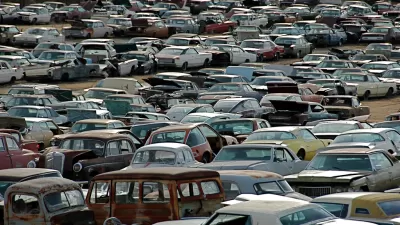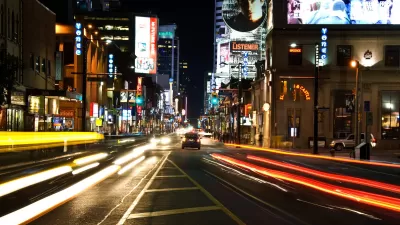The consequences of car-centric planning are clear, a century after cars took over streets and lives across this country. According to this article, so to is a new way forward.

Richard Kingston and Ransford A. Acheampong write on the subject of reversing the course of the past century of car-centric planning around the world. The consequences of this epoch-defining priority on the automobile make the need for change clear, according to the article:
It is estimated that there are more than a billion cars in the world. As well as driving up energy use, contributing to more than 70 per cent of C0₂ emissions in the transport sector and reducing air quality, cars are also responsible for increasing obesity and chronic illnesses and killing more than 1.25m people around the globe every year in traffic accidents.
Kingston and Acheampong offer three prescriptions, already implemented to varying degrees, to those outcomes: 1) car-free zones and charges, 2) public transit investments, and 3) improved urban planning and land use. More details on each of these three prescriptions are offered in the source article.
FULL STORY: We can reclaim cities from the car without inconveniencing people

Study: Maui’s Plan to Convert Vacation Rentals to Long-Term Housing Could Cause Nearly $1 Billion Economic Loss
The plan would reduce visitor accommodation by 25% resulting in 1,900 jobs lost.

Alabama: Trump Terminates Settlements for Black Communities Harmed By Raw Sewage
Trump deemed the landmark civil rights agreement “illegal DEI and environmental justice policy.”

Why Should We Subsidize Public Transportation?
Many public transit agencies face financial stress due to rising costs, declining fare revenue, and declining subsidies. Transit advocates must provide a strong business case for increasing public transit funding.

Paris Bike Boom Leads to Steep Drop in Air Pollution
The French city’s air quality has improved dramatically in the past 20 years, coinciding with a growth in cycling.

Why Housing Costs More to Build in California Than in Texas
Hard costs like labor and materials combined with ‘soft’ costs such as permitting make building in the San Francisco Bay Area almost three times as costly as in Texas cities.

San Diego County Sees a Rise in Urban Coyotes
San Diego County experiences a rise in urban coyotes, as sightings become prevalent throughout its urban neighbourhoods and surrounding areas.
Urban Design for Planners 1: Software Tools
This six-course series explores essential urban design concepts using open source software and equips planners with the tools they need to participate fully in the urban design process.
Planning for Universal Design
Learn the tools for implementing Universal Design in planning regulations.
Smith Gee Studio
Alamo Area Metropolitan Planning Organization
City of Santa Clarita
Institute for Housing and Urban Development Studies (IHS)
City of Grandview
Harvard GSD Executive Education
Toledo-Lucas County Plan Commissions
Salt Lake City
NYU Wagner Graduate School of Public Service





























